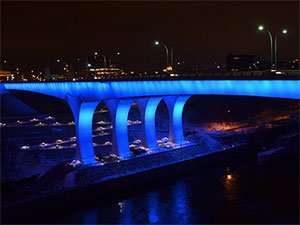I-35W 'smart' bridge stands the tests of time

Though still basking in the gleam of youth upon turning 5 in September, the new I-35W St. Anthony Falls Bridge is, like most of us, coping with a little shrinkage and creep.
But not to worry. Modern engineering technology finally may be able to provide the critical long-term maintenance strategies needed to keep the bridge satisfying generations of drivers.
For the past year, researchers at the University of Minnesota have been studying how the innovative engineering marvel spanning the Mississippi near downtown Minneapolis is aging. In more formal terms, the researchers have been focused on characterizing the time-dependent behavior of the posttensioned, precast concrete box-girder bridge.
The researchers are monitoring nearly 500 sensors installed during construction of the bridge for strain, load distribution, vibrations, temperature, and the overall movement of the bridge. Other sensors help keep an eye on the bridge's security and control automatic anti-icing and lighting systems.
As the bridge ages, the concrete will naturally shorten due to the process of "shrinkage." The concrete will also "creep," meaning that it will continue to deform with time due to the permanent gravity and post-tensioning loads. "Post-tensioning" is a way to strengthen the concrete structure using strands of steel that are tightened after the concrete hardens.
The award-winning bridge is designed to last 100 years.
Brock Hedegaard, a civil engineering graduate student, is part of a research team led by civil engineering professors Cathy French and Carol Shield that is collecting and analyzing the "smart bridge" data to investigate the bridge's structural behavior in a project funded by the Minnesota Department of Transportation (MnDOT).
"These time-dependent deformations take years to fully develop," Hedegaard says. "Being able to predict how the bridge is expected to change is critical to evaluating the long-term performance of the structure."
The research team is in the process of refining models to better predict the behavior of the bridge over time—data they plan to use as a baseline for detecting damage or potential problems in the structure. The award-winning bridge, constructed in 10½ months for $234 million, is designed to last 100 years.
"The bridge is performing very well. In terms of long-term behavior, most models predict more deformation than we are actually seeing in the bridge," Hedegaard says. "Traffic load is basically a non-factor for this particular bridge—it is such a small portion of the total load the bridge carries day after day, which is mostly self-weight and post-tensioning. Thermal behavior seems good, but we did find that thermal stresses were a bit higher than were expected in design."
In conjunction with predicting the long-term structural behavior of the bridge, the research team has continued to monitor the sensors for behaviors related to temperature and time. Nearly every measure the team has evaluated has included dependence on temperature, time, or both. That includes expansion joint movement, strains, and the dynamic modes of vibration.
The researchers found that warmer temperatures (above room temperature) speed up concrete creep and shrinkage, while colder temperatures slow down such time-dependent behavior. "When it is below freezing, the concrete deforms so slowly that for all practical purposes it stops," Hedegaard adds.
The research team also is developing a unique prototype monitoring system that provides warnings to MnDOT Metro Maintenance personnel should problems arise in the expansion joints. They focused on the expansion joints first because those joints are easiest to incorporate into maintenance and inspection routines.
"We find the most value in the systems that will provide MnDOT with information on creep, shrinkage, and the movement of the expansion joints," says MnDOT state bridge engineer Nancy Daubenberger. "The research under way at the U of M will help us better understand the behavior of these types of structures and inform future concrete bridge designers. In the near-term, the information on movement at the joints will also help us develop a maintenance tool."
Once the monitoring framework for the expansion joint movement is finalized, the prototype also may be extended to evaluate other sensor data.
Reprinted with permission from the November 2013 issue of CTS Catalyst, a publication of the University of Minnesota Center for Transportation Studies.
